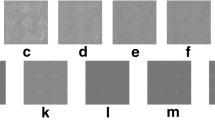Abstract
In this paper, the theory of signal singularity spectrum analysis (SSA) is proposed. Using SSA theory, a new method is presented to reduce truncation artifacts in magnetic resonance (MR) image due to truncated spectrum data. In the scheme, after detecting signal singularity locations using wavelet analysis in spectrum domain, SSA mathematic model is constructed, where weight coefficients are determined by known truncated spectrum data. Then, the remainder of the truncated spectrum can be obtained using SSA. Experiment and simulation results show that the SSA method will produce fewer artifacts in MR image from truncated spectrum than existing methods.
Similar content being viewed by others
References
Shepp L. Computerized tomography and nuclear magnetic resonance.Journal of Comput. Asst. Tomo., 1980, 4: 94.
Bottomley P, Pykett I L. Biological and medical imaging by NMR.Journal of Magnetic Resonance, 1978, 29: 335.
Hui Y, Smith M R. MRI reconstruction from truncated data using a complex domain backpropagation neural network. InIEEE Pacific Rim Conference on Communications, Computers, and Signal Processing, Proceedings (Cat. No. 95CH35765). New York: IEEE, 1995, pp. 513–516.
Charles K Chui. An Introduction to Wavelet. Academic Press, 1992.
Mallat S, Hwang W L. Singularity detection and processing with wavelets.IEEE Transactions on IT, 1992, IT-38(2):617–643.
Mallat S, Zhong S. Characterization of signals from multiscale edges.IEEE Transactions on PAMI, 1992, PAMI-14(7): 710–732.
Luo Jianhua, Lu Weixue. Fuzzy multicriterion image reconstruction technology.Chinese Journal of Computers, 1996, 19(8): 609–615.
Luo Jianhua, Lu Weixue. Fuzzy multicriterion NMR image reconstruction technology.Acta Electronica Sinica, 1996, 24(7): 1–6.
Author information
Authors and Affiliations
Corresponding author
Additional information
The study is supported by the National Natural Science Foundation of China (No. 39870211 and No. 39970219) and Science Technology Foundation of Shanghai Jiao Tong University.
LUO Jianhua was born in 1958, Ph.D., associate professor. His major researching field covers medical image processing.
ZHUANG Tiange was born in 1935, Ph.D. supervisor, professor. His major researching field covers medical image processing.
Rights and permissions
About this article
Cite this article
Luo, J., Zhuang, T. Reduction of artifacts in images from MR truncated data using singularity spectrum analysis. J. Comput. Sci. & Technol. 15, 360–367 (2000). https://doi.org/10.1007/BF02948872
Received:
Revised:
Issue Date:
DOI: https://doi.org/10.1007/BF02948872




